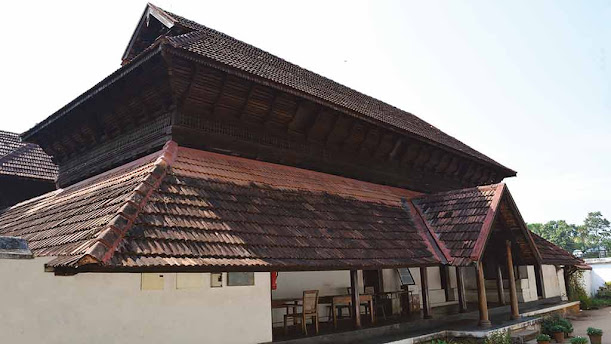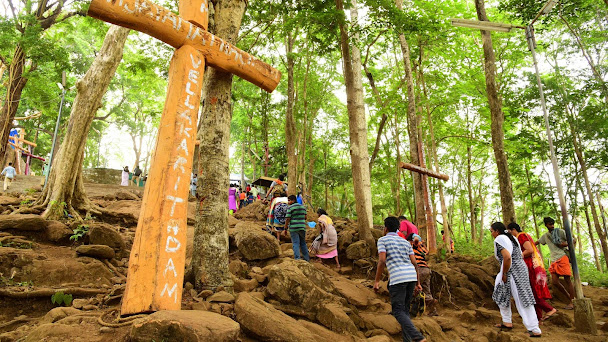Krishnapuram Palace: Art & Architecture
Kerala is a place where one can find beautiful palaces built by different rulers who ruled this land over centuries. One such palace which is a rare specimen of Kerala style architecture is the grand Krishnapuram Palace in Kayamkulam. Apart from the beautiful architecture of the palace, one striking feature is the presence of a massive mural painting depicting “Gajendra Moksham” at the entrance of the palace. The palace is today a museum which is under the supervision of the Archeological Department & is certified as a protected monument.
The age of the palace is unknown as the earlier palace was the residence of the Kayamkulam rulers which was demolished & rebuilt by the Travancore king Anizham Thirunal Marthanda Varma. The older residence belonged to Odanad rulers & they had to annex their kingdom to Travancore post their defeat in the war of 1746. The earliest structure made by the Travancore Diwan was a one storeyed palace with an ettukettu & a large pond. It was only during the later years of Prime Minister Rammayan Dalawa, the palace was rebuilt to its current grandeur with gabled roofs, narrow corridors, thick framed doors & dormer windows. The architecture was based on Kerala & western style which took 3 years to complete in 1764. The palace area was increased by adding new blocks which made it a pathinarukettu (set of 4 open courtyards also called nadumuttam). The palace is also a place where one can view the elegant craftsmanship of the builders. The palace in its lower tier has 22 rooms which range from small to large along its whole structure, a beautiful poomukham, Nellara which is the godown to store foodgrains, and a large kitchen called Madappally. The upper tier has the Manthrasala, guest rooms & bedrooms for visitors. Though the palace was constructed in the 18th century, one can still find the well designed stone pipes creating an excellent drainage system. The ceilings are elegantly designed with beautiful carvings. One look at the palace in its prime would have resembled the beautiful grand palace of Travancore Kingdom, the Padmanabhapuram palace.
The palace apart from its majestic architecture is a place where one can find the most celebrated mural of Kerala, the Gajendra Moksham. This single piece mural is over 3 metres high and depicts the beautiful story of salvation for the Elephant king Gajendra at the hands of Lord Vishnu. The mural is said to be from the time of the Odanad Kings & it was kept intact during the time of reconstruction by the Travancore kings. The story narrated is based on a mythological legend mentioned in the Bhagavata Purana. The story is about the Pandyan King Indradyumma who is cursed by Agastya Muni to be reborn in his next life as an elephant. As per the curse, the King is reborn as Gajendra who became the king of elephants. One day Gajendra went to the pond with his wives & was bathing when a crocodile caught hold of his leg & dragged him into the water. Gajendra could not free himself & was held captive by the crocodile for years. King Indrayumma was an ardent devotee of Lord Vishnu, so Gajendra prayed to his lord to free him from the crocodile. Lord Vishnu, pleased by his devotees' prayers, came to the pond riding on the Garuda to rescue Gajendra. Garuda killed the crocodile to rescue the elephant king & gave moksham to Gajendra.This entire sequence of the event of providing salvation to Gajendra is painted as a mural using vegetable colors. In the painting one can find Garuda at the center with roudra bhavam & Lord Vishnu in his serene self while Gajendra on the side is shown praying to the Lord as the crocodile holds his leg with its mouth. Also present in the painting are the wives of Gajendra, mythical beasts, the pond, animals, saints & other Gods. One unique feature in the painting is the presence of Lord Krishna as a child with female figures around at the bottom of the mural. This mural is today part of protected painting & one of the most iconic murals in the world. The colors used in the painting show the artistic excellence of the artists. The mural adorns the entrance of the palace which opens to the pond & is the first thing the King would have seen after his daily rituals.
The palace during the end of 19th century & early 20th century was abandoned after the Travancore Kings centralised their power in Trivandrum. Many parts of the palace were destroyed in rains & became dilapidated. After the Travancore Kingdom became part of the Indian Union, the Archeological department of Kerala took over the palace & initiated a renovation plan. The plan was to restore the glory of the palace to what was earlier & better upkeep of all the artefacts of the palace. The palace was rebuilt using the old Vastu norms & materials like laterite stones, teak wood, mangalore tiles were used to beautify the structure. The floors of the palace were relayed with red oxide & granite was used to reconstruct the old steps of the palace. The area of the palace from its old times was reduced to strengthen the compound. The department also made additions to the structure by designing spiral staircases & sunshades to enhance the beauty of the palace. The Archeology department in 1961 decided to convert the palace into a museum for all to visit & see unique artefacts. The palace houses some of the most valuable items like the Kayamkulam Vaal (sword) which is a unique piece of weapon having sharp edges on both sides & was used by the Kayamkulam raja. Another important artefact is the Holy Bible in Sanskrit script. Another notable item is the shield of Raja Kesavadasa who was the famous Diwan of Travancore, the Anchal Petti which is the earliest version of a post box placed by the Travancore King Marthanda Varma in 1729. Outside the building in the compound of the palace lawns one can also see a Mandapam which houses the statue of Buddha considered to be one among the four discovered in Kayamkulam which were thrown in the fields and ponds during the anti Buddhism campaign in Kerala.
The place today reminds all the visitors the grandeur of the erstwhile rulers of Kerala who valued craftsmanship, architecture & art as an important virtue for its people. The Krishnapuram Palace is not just a place of historical interest, it is also about the beauty of its architecture.





Comments
Post a Comment